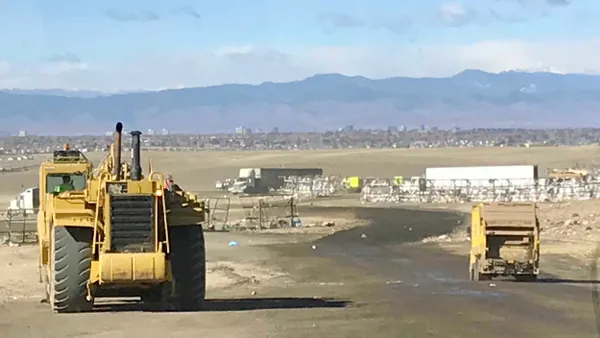Dive Brief:
- Republic Services officially announced a large solar energy project at three of its closed landfills in Massachusetts on Sept. 27 with ribbon cutting ceremonies at two of them. Across the three sites in the towns of Randolph, Plainville and East Bridgewater, the project involves 41,000 solar panels.
- The panels at these sites are collectively capable of producing 13.5 MW of energy, enough for an estimated 1,900 households, and have a 40-year design life. The project is also expected to reduce carbon emissions by more than 14,000 tons per year.
- This effort was led by New Jersey-based company Soltage and is expected to be the first in a series of potential projects with Republic. Basalt Infrastructure Partners was the primary investor, along with Eastern Bank.
Dive Insight:
Started in the spring of 2014, this project was driven in large part by a favorable regulatory climate and incentives for renewable energy projects in Massachusetts. This included close collaboration with the state's Department of Energy Resources and Department of Environmental Protection, as well as county and local governments. Soltage also finds sites such as the ones owned by Republic attractive for a variety of reasons.
"Closed landfills we really see as an ideal place to put solar. Typically, you've got land that's already cleared. It's generally with a lot of flat surfaces, which is good for solar implementation. Typically it's near points of interconnection and so there's some utility service nearby," Soltage CEO Jesse Grossman told Waste Dive after the ribbon cutting in Randolph. "Now, the challenge is you're building on a landfill."
Grossman said that subsidence is a factor because the panels need a stable structure, meaning it's unlikely that a solar project would work on any site with active gas capture taking place. Because of this, Grossman said the ideal landfill should be closed for about 10 years. Any project will also have to prove that it can work without interfering in existing post-closure operations.
"We're stewarding the environment here in terms of closure obligations that last 30 years. You don't want to do anything to compromise what we've created here," said Nick Stefkovich, market vice president for Republic in the New England area.
Stefkovich said that if a site was only receiving soil with low levels of contamination, and not putrescible waste, then there might be less settling and construction could begin sooner than the 10 year mark. For the most part, this will be a longer term priority at many locations. Though eventually, in the same way that companies and local governments are increasingly interested in capturing energy from the gas at their sites, they could start looking at post-closure solar projects in the same way.
"This is the 2.0 version of renewable at the sites," said Stefkovich.
Before Massachusetts, Republic had invested in solar projects at two other closed landfill states. Using a geomembrane system, different than the newer solar panels, the company is currently capturing energy at sites in Texas and Georgia. Republic's Southern Nevada Recycling Center also has solar panels on its roof. Though the company has no immediate plans to install panels on additional facilities, it is working with Soltage to identify other candidate landfills around the country as part of its Blue Planet sustainability initiative.
Republic isn't the only industry company to pursue such projects, even in Massachusetts, and more may consider it as the costs of certain types of renewable energy infrastructure becomes more favorable. With more officials looking for ways to show progress on greenhouse gas reduction, the opportunity to generate revenue from solar panels or wind turbines on land may become more enticing in the years ahead.










